This site is part of an affiliate sales network and receives compensation for sending traffic to partner sites, such as CreditCards.com. This compensation may impact how and where links appear on this site. This site does not include all financial companies or all available financial offers.
We haven’t been to Puglia yet but are on our way to visiting most of Italy. Earlier this year, we got to experience the Amalfi coast. If you are following us on instagram, you know that some of us are currently in Venice at the moment. One of the best trips we took in recent memory was when the entire team spent two weeks in the Tuscan countryside. Puglia sounds like our type of vacation – laidback with excellent food.
Steven Maviglio, a political consultant with deep ties to Puglia, offers his practical travel tips to this beautiful place.
If you would like to write about your recent travel experiences on The Flight Deal, submit your pitch here.
====
The heel of the boot, Puglia (or ‘Apulia’ in English), is fast becoming the hottest travel destination for those seeking the “real Italy.” Once an off-the-beaten path destination with little tourism infrastructure, Puglia is booming thanks to a spate of international publicity about the azure blue waters along its 350 miles of Adriatic and Ionian sea coastlines, traditional white-washed villages, and seafood-based cuisine that has been highlighted in the New York Times, the PBS “Dream of Italy” series, and National Geographic’s “Best of the World” list. The Wall Street Journal (paywall) earlier this summer even named it as an ideal retirement location.
Getting In
Puglia is served by two major international airports: Karol Wojtyla (BRI), which serves the region’s centrally located capital of Bari and surrounding area, and smaller Brindisi (BDS) airport, which serves the southern half of the province. Once dominated by Alitalia, both airports have had major overhauls and modern expansions to terminals and runways during the past five years as European low-cost airlines, such as Ryanair, Easyjet, Volotea, Mistral Air, Wizz, and Eurowings, have added the region to their destination list. For U.S. travelers, the easiest connection to most airports is via Rome (FCO); Alitalia and Ryanair offer more than a dozen flights to both BRI and BDS.
BRI airport offers a shuttle bus connections to Bari’s central train station, a 25-minute trip, for 4 Euros. The bus runs 24/7 but check the schedule as reliability is not often the strong suit of the Puglian transportation system. Buses leave BDS to the city’s train station every 30 minutes. Train service by Italiarail serves the city’s major cities of Bari, Lecce, and Brindisi but is nearly non-existent everywhere else; you’ll want to rent a car. Both BDS and BRI host major car rental companies but a word of warning–the small villages throughout Puglia with their alleyways and GPS-resistant street plans were not built for car traffic. Parking often is a nightmare. You’ll want to rent a smaller car; take the accident insurance if you’re credit card doesn’t offer it. Cars with automatic shifts are difficult to find. Car sharing service MyTaxi serves Bari.
Where to Stay
Bari is Puglia’s major city with a historic old town (“Centro Storico”), downtown shopping district and a port of arrival for cruise ships. It’s also a jumping off point for ferries to Croatia and other Mediterranean ports. Ditto for Brindisi, a smaller city with ferries to Greece and Albania. Further south, Lecce – known as the “Florence of the South” – has far more charm, history, and baroque architecture.
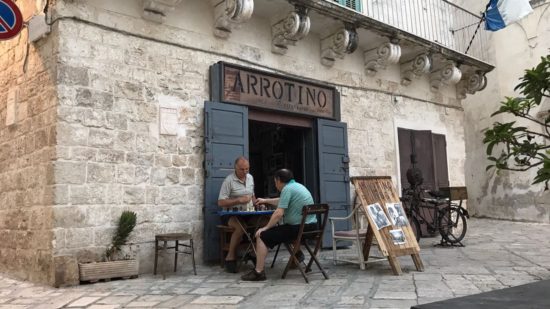
Puglia Town, Italy – Photo: (c) 2017 – Steven Maviglio
But don’t spend much time in the cities: Puglia’s charm is its mountain and seaside villages, beaches, and rural beauty. Plan accordingly. Don’t bite off more than you can chew in one visit; bumping into a random street festival, attending a small town soccer match, spending a half hour at the deli counter tasting cheese, or savoring a warm day on a white sandy beach are what makes travel here interesting.
To the north of Bari, where the rocky Gargano Peninsula jets into the Adriatic, the towns of Vieste and Peschici feature narrow streets and alleys, small shops with local goods and foods, and nearby stretches of sandy beaches. The UNESCO Heritage Site of the octagonal Castel del Monte in Andria is the region’s finest castle, built in the 13th century by Emperor Frederick II. Tours go for 10 Euros (Puglia was reconquered by armies from Spain, Germany, Turkey, Greece and others, the effects of which you can still see today). The fishing port of Trani, with its protected picturesque harbor, has medieval churches that date back to the Crusades and another of Emperor Frederick II’s castles.
About a half-hour’s drive south of Bari begins a string of Adriatic beach towns. Polignano a Mare, with its steep cliffs, crystal clear waters and grottos, and cobblestone streets, is a must stop if only to stop at one of the town’s famous gelato shops. The once sleepy fishing village of Monopoli has the region’s finest beaches (mobbed during summer weekends by locals and vacationers alike) and perhaps the most charming “Centro Storico” of the region, where locals stroll passeggiatta to catch up with each other and escape the heat of their homes (air conditioning is a rarity). Just south of beach clubby Capitolo is the Egnazia architectural site (digs still underway by student crews), where the Appian way from Rome ended.
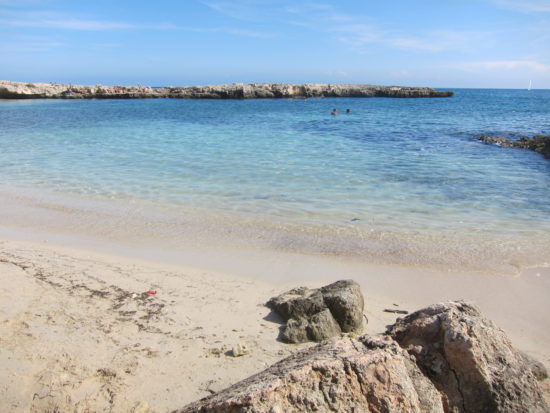
Monopoli Beach, Italy – Photo: (c) 2017 – Steven Maviglio
In the countryside, the hill city Ostuni – nicknamed “The White City” for obvious reasons – dominates the landscape. From its ancient buildings, you can overlook hundreds of acres of olive trees in every direction. Some date back more than 1,000 years and are protected by the Italian government. Many of the farmhouses that house these trees produce their own pure olive oil and have opened their doors for overnight stays and farm dinners; Masseria Il Frantoio (translation: The Olive Press) is a favorite, featuring an all-female kitchen staff with five courses of direct-from-the-farm ingredients served outdoors on the patio.
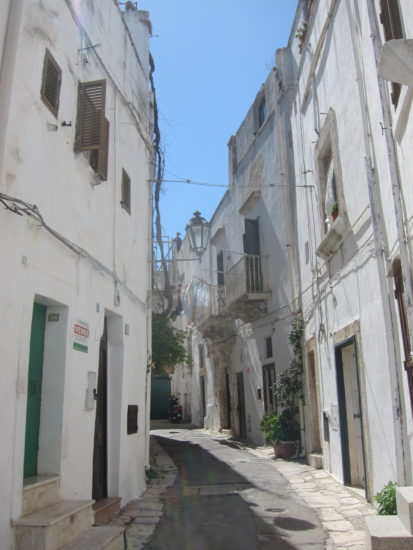
Ostuni, Italy – Photo: (c) 2017 – Steven Maviglio
Further inland, the rolling hills and valleys of the Valle d’Itria are dotted by cone-shaped trulli, mortar-free stone houses. The UNESCO village Alberobello is the hub of these unique dwellings, with more than 1,400 in its confines. Unfortunately, it’s been added to the tour bus circuit, so many of the trulli owners now hawk T-shirts instead of traditional goods. The region is popular among bicycle tourists too. Better bets are the hilltop villages of Locorotondo (“The Switzerland of Puglia” because of its flowers and clean white buildings, and also the region’s white wine capital), Cisternino, Putignano, and Martina Franca with its baroque cathedral and narrow streets. Like pottery? A must stop is Grottaglie, the source of ceramic goods for Williams Sonoma and others that market Italian goods (my favorite: Enza Fasano, who has a slightly more modern take on pottery). Although not in Puglia, the UNESCO city of Matera, with its magnificent cave dwellings and gorge, is a short drive away. Have a rainy day? The caves of Castellana Grotte are a natural wonder. Tours in English and/or Italian cost 25 Euros.
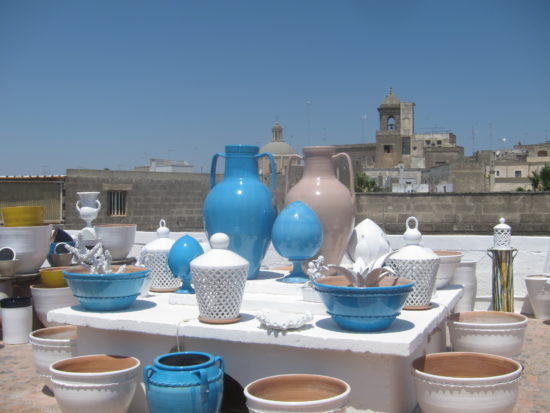
Pottery – Photo: (c) 2017 – Steven Maviglio
Beyond Lecce, the Salentino peninsula also has its fair share of quaint villages and sandy beaches – and far fewer visitors. The fortified city Otranto boasts a castle and water clarity that rivals that of a Caribbean Island. The tip of the “heel” is Santa di Leuca, which has a lighthouse to mark the spot and undersea caves best explored by boat and the nearby Le Maldive del Salento, which has blue waters that rival that of the Maldives. On the coast of the Ionian Sea sits Gallipoli, with its old port boasting ancient buildings on an island connected by a narrow bridge. Its promenade, with plenty of rest stops for food and wine, offers glorious views. White sand beaches of nearby Porto Cesare are widely considered some of the finest in the region.
There’s a wide assortment of accommodation options for every budget with plenty of listings on AirBnB and VRBO.com sites. Agritourism also is popular – with options to stay in renovated trulli as well as high-end masserias.
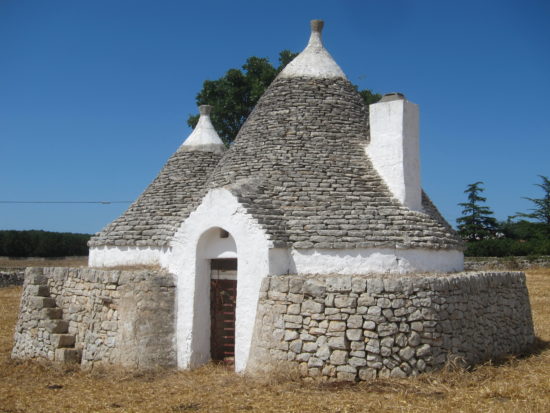
Truli – Photo: (c) 2017 – Steven Maviglio
Cuisine
Pugliese are passionate about the freshness of their food. It’s not just a cliché: they live to eat. From small trattorias to the stunning Michelin starred restaurant of chef Angelo Sabatelli, a premium is put on food that is fresh, healthy, and locally-sourced.
Breakfast is nominal; typically a coffee and perhaps a flaky cornetto, a sweeter Italian cousin of the croissant. Lunch often is a piece of thick, deep-dish pizza-like focaccia. Quick hits of espresso throughout the day seem to sustain life.
Most Pugliese save it all up for dinner, typically a two to three hour affair. Pro Tip: Don’t even think of sitting down before 9:30 p.m. and have patience for your food to arrive.
Most menus are divided into three sections: appetizers (antipasti), primi (first courses, usually pasta or risotto) and secondi (larger entrees). That doesn’t mean you have to order all three courses. While it’s unusual to just have an entrée, few restaurants frown upon splitting courses or ordering more food halfway through the meal.
Start by ordering house antipasti for the table. Here antipasto isn’t salami, carrots and celery: it is often a full-fledged meal of small specialties of the house, an endless series of tapas that, depending on the restaurant, may well be all you need to order. In my recent visit to a small trattoria, a single order included mint-flavored meatballs, two versions of octopus, fried anchovies, house-made burrata and capicola, stuffed zucchini blossoms, marinated artichokes, red shrimp from Gallipoli, warm orange-flavored olives, and paper-thin cooked eggplant.
Puglia also is the region known as the breadbasket of Italy, responsible for most of the wheat that goes into the country’s pasta. Fresh orrechiette (“little ears”) is on almost every menu.
Bread is the staple of the Italian diet and here, the massive, crumpled round loaves pane di Altamura are famous region-wide (and have the EU’s Protected Designation of Origin status). Dip it in the region’s olive oil. (Pro Tip: buy the finest oil directly from the Monopoli Olive Oil Cooperative, located right off the autostrada or, better yet, go directly to an olive farm to see the trees up close and get the oil directly from the farmer).
Because of its proximity to the ocean, fresh seafood dominates most menus. But inland just a few miles, it’s just the opposite, proving that Pugliese are serious about local sourcing for their foods. For example, in Cisternino, which is located just 10 miles inland, you’d be hard pressed to find seafood on the menu. Instead, the city is famous for its alleyway butcher shops that feature a restaurant out back. Just point to your cut of meat and they’ll cook it up for you.
Puglia also is coming into its own as a major force on the Italian wine scene. Long known for its jug quality reds, the last decade has seen a major surge in higher quality wines. Robust reds like primitivo, negroamaro, and Salice Salento dominate wine lists, often for less than 15 Euros. Favorite whites are Fiano, Verdeca, and Bianco d’Alessano.
Pro Tip: Both Bari and Brindisi airports have several well-stocked food stores that sell regional specialties to go.
The Language
The official language is Italian. Many towns have their own dialects, particularly in southern Puglia, where centuries of Greek influence have affected the language. English is spoken in many of the larger towns, but it’s not a given in some of the smaller villages.
Safety
Other than the usual precautions, travelers should not worry for their safety.
Best Time to Visit
Locals prefer the shoulder seasons of June and September/October. June offers long days and balmy nights. In September/October, the water is still wonderful for swimming and the crowds are gone. Sun worshippers will prefer July and August; prepare to pay higher rates and reserve tables a week in advance because of the crowds. The New York Times once made the case for winter visits, but it’s often chilly and rainy. There even was snow last winter.
About the Author
Steven Maviglio is a Sacramento, California-based political consultant whose family dates to generations of olive oil producers in Monopoli, Puglia. When not working on campaigns and legislative issues, he vacations at the family home and discovering new charms of the region, particularly local foods and wines. Follow him on Twitter and Instagram.
=====
To make sure you receive our latest deals, LIKE our The Flight Deal Facebook Page, follow us on Twitter @TheFlightDeal, Threads @TheFlightDeal or The Flight Deal WhatsApp channel or subscribe to The Flight Deal RSS Feed or Subscribe via Email (Once a Day)
The Flight Deal does not sell travel products or services. We provide you with information about third-party travel suppliers’ offers, and link you to their sites. The information posted by The Flight Deal is valid at the time of publication. However, we have no control over the suppliers, and we therefore do not warrant or guarantee that their offers will not change or become unavailable. Nor are we responsible for their products, services or site content. Please see their sites for their most up-to-date offer information and all applicable terms and conditions.
Sign up to receive The Flight Deal Daily DealsLetter, to stay up to date with the latest and greatest flight deals available.


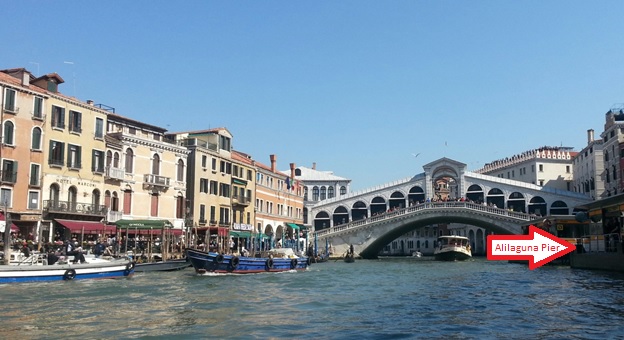
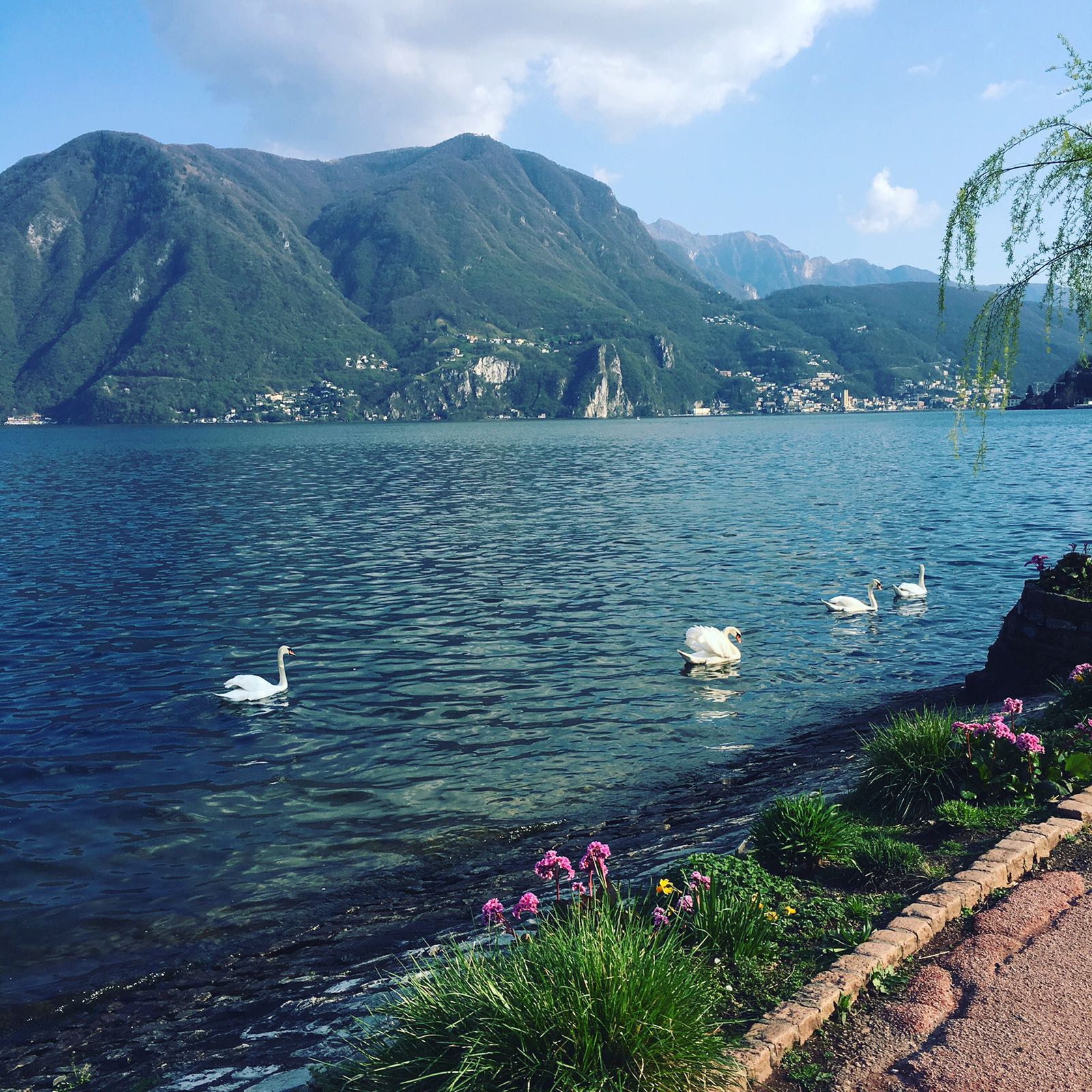
No Comments